Teak-tock sofas: what are they and what are they?

Sliding modular sofa beds have gained well-deserved popularity due to their versatility and compactness, allowing you to turn a sofa into a comfortable bed through a simple transformation. One of the most popular sofa transformation systems in our time is the "tick-tock" or "pantograph" mechanism. Let's take a closer look at what it is and what it is.


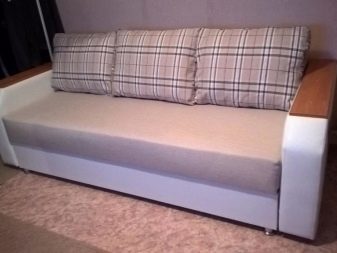
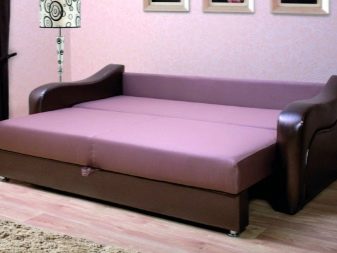
What does it mean?
The "tick-tock" mechanism got its name for a simple way of unfolding, which is performed in two movements: "raised - pulled". It belongs to the longitudinal-pull-out type of unfolding and has both its advantages and disadvantages.




Advantages and disadvantages
The advantages of the tick-tock mechanism are as follows:
- unfolding takes place without the need to move the pull-out part over the floor or floor surface, which avoids damage to surfaces caused by the regular movement of the support elements along the same trajectory;
- transformation mechanism does not require much effort, which allows the folding of the sofa bed for both children and the elderly;
- high reliability indicators and large permissible weight loads, which are provided by the increased bearing area of the sliding part, when compared with mechanisms using rollers;
- spacious pallet boxes for storing bedding and decorative pillows.




The disadvantages of tick-tock sofa beds are as follows:
- the large width of the pull-out panel of the sofa creates inconvenience when using it for seating, which usually requires the use of special decorative pillows;
- the mechanism of transformation "tick-tock" is quite complex constructively, in the event of a breakdown, its replacement will not be cheap;
- the use of an expensive transformation mechanism and the presence of special decorative pillows determine a high price for the product when compared with other options.
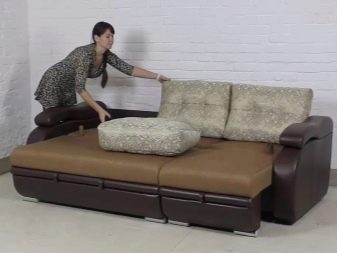


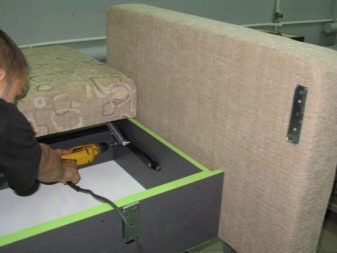
Varieties of sofas
Transforming sofas with a tick-tock mechanism have two most common varieties - regular (straight) and corner sofas. The design difference is clear from the name, namely:
- regular (straight) built according to the classical scheme and have one pull-out section for the entire sofa;
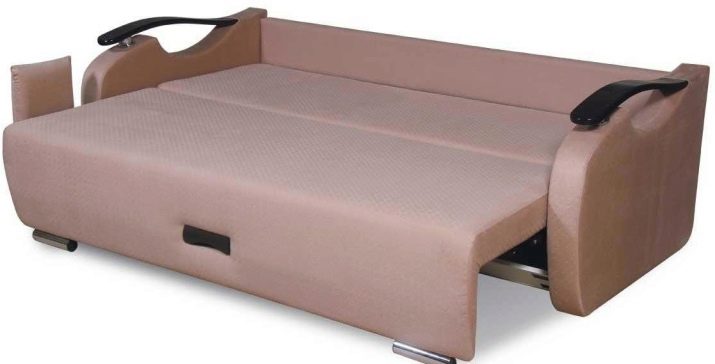
- corner are L-shaped, in addition to the main section, there is a side section, which can be either stationary or folding.

Corner models constructively allow combining the area of the main pull-out section and the side section, which significantly increases the total sleeping area of the bed. The back of the sofa fits into the place of the extendable section, creating a common surface with it. For the convenience of placing pillows, additional removable supports can be used, which are installed only for bed mode and are stored in pallet boxes. Side backrests are available with or without armrests.
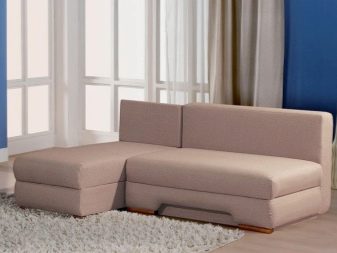

Children's models usually do not have armrests, and the backs themselves are completely covered with a layer of soft filling to ensure safety.
Orthopedic models are made in two versions, such as:
- with orthopedic construction and filler for sofa bed panels;
- with a separate orthopedic mattress, which is only used in bed mode, allowing it to extend its lifespan and making it easier to replace when needed.


Materials (edit)
Frame
For the manufacture of frames and side backs of sofa beds, both natural wood and its combination are usually used with modern types of chipboard, fiberboard and plywood. The sections are made on a metal frame, with a combination of metal and wooden elements, or are completely wooden. The folding mechanism is made of metal. The pull-out section has elements for easy holding in the form of handles or structural grooves and recesses.



Excipients
The fillings for the sofa bed sections are one of the most important factors in usability and durability. Due to the design features, spring metal blocks are used extremely rarely, and polymer materials are used for orthopedic options. Typically, the filling of the sections is combined of several types, the main body is made stronger and more elastic, and the top layer of soft materials is used to create relief and improve performance.

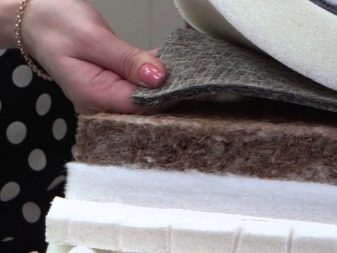
Such modern materials as are used as fillers for sections:
- polyurethane foam - highly porous foam material, which is obtained by mixing several synthetic polymers; service life is 5–8 years;
- periotecus - non-woven fabric made of high quality polyester fibers; service life - 10–12 years;
- struttofiber - a combined material produced using the "non-woven independent springs" technology from synthetic and natural fibers; service life - 10–12 years;
- synthetic winterizer - synthetic material in the form of a non-woven fabric made of polyester fibers; service life - up to 5 years;
- holofiber - an improved version of padding polyester, with fibers of a spiral structure; service life - 5-10 years;
- latex - a combined material based on natural rubber; service life - up to 20 years;
- durafil is a non-woven fabric made of hollow polyester fibers glued to a base; it has a structure reminiscent of a spring block; service life - 10–12 years;
- foam rubber - the same polyurethane foam, but of the lowest quality and strength; service life - 3-5 years.




Upholstery
Upholstery materials made from natural, synthetic and mixed fabrics have a wide range of characteristics and colors. They must be selected depending on the operating conditions of the sofa bed, taking into account the presence of exposure to direct sunlight, pets, use in children's rooms. Consider the most popular upholstery options.
- Cotton - natural inexpensive material. Its environmental friendliness makes it suitable for children's furniture. It usually comes in a wide variety of colors, patterns and patterns. The service life is 5–6 years.

- Chenille - a mixture of natural and synthetic fibers is used for its manufacture. Its surface has a pleasant-to-touch pile. It has high strength and durability, hypoallergenic. Among the disadvantages is the high absorbency of liquids. Service life - up to 30 years.


- Velveteen - can be both natural and artificial. It has sufficient strength, resistance to sunlight, and is not afraid of exposure to animals. The material requires careful maintenance, has an increased absorbency of liquids. Service life - up to 15 years.

- Flock - artificial material with a pleasant pile surface. It is highly durable and water-resistant, animal hair does not stick to it. The disadvantages are the absorption of odors and the abrasion of the pile over time. Service life - up to 15 years.


- Suede and velor - natural or artificial material with a pleasant velvety surface. The natural version is used less and less, yielding to the artificial one in strength and durability. The service life is 7–12 years.


- Jacquard - special technologies of weaving of threads provide the material with high strength. It is distinguished by a spectacular relief texture and high resistance to sunlight. Service life - 10-12 years.


- Tapestry - a classic material from natural raw materials, but recently synthetic additives have been used to increase strength. It has a long service life, a wide selection of colors and patterns, while it does not tolerate direct sunlight. Service life - up to 15 years.


- Leather - one of the most expensive natural materials. It is highly durable, moisture resistant and easy to clean. The disadvantages include a small selection of colors and a "sticky" effect. Service life - up to 20 years.

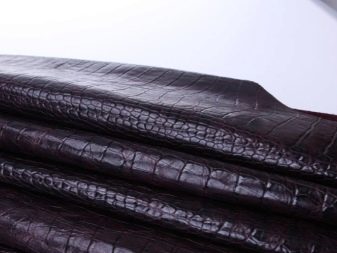
- Arpatek - a man-made material originally created for the automotive industry. The advantages of the material are strength, abrasion resistance, color fastness and ease of maintenance. Service life - up to 15 years.


Important! For most types of upholstery materials, a large number of varieties are produced, which often have their own unique names, which can create difficulties in choosing.


Dimensions (edit)
Teak-tock sofa beds are produced in various sizes, the choice of which depends on the manufacturer's nomenclature and purpose. Typical parameters are as follows:
- regular (straight) models have a length of 205, 225, 245 and 260 cm, a width (depth) of 100, 105, 110 cm, a height of 75, 80, 85 cm;

- corner ones have a length of 225, 235, 250, 270, 350 cm, a width (depth) of 155-180 cm, a height of 75, 80, 85 cm.

Important! After folding out the sofa, the berth usually has dimensions of 195x155, 215x155, 210x160, 320x170 cm.

The sizes of children's models are as follows:
- length - 100, 120, 160 and 185 cm;
- width - 80, 85, 90 and 100 cm;
- heights 65, 70, 75 and 80 cm.


Important! In furniture stores and salons that work directly with the manufacturer, the possibility of individual ordering of product sizes, as well as upholstery and filler material is available.
Color palette and design
Of no small importance when choosing a sofa bed is its style and colors, which should be in harmony with the general style and color palette of the room. Designers distinguish more than 50 styles used in the manufacture of modern furniture, below are the main ones.
- Hi-tech (or lounge) differs in calm monochromatic colors and simplicity of geometric shapes. The use of metal chrome elements is characteristic, but natural wood is used extremely rarely. Modern fabrics are used for upholstery, color preferences are given to black, white, gray, silver and metallic.

- Loft - modern style for ordinary spaces. He uses iconic elements - exposed concrete walls, brickwork, communications. Preference is given to laconic models of bright colors; at first glance, incompatible materials are used - plastic and stainless steel in combination with upholstery made from natural materials.

- Art Deco inspired by the aesthetics of Cubism and ethnic styles of small nations. Traditionally, unusual natural materials or their imitation are used - ivory, noble woods, bamboo. Exotic types of genuine leather or their artificial substitutes are ideal for upholstery.


- Eco created to counter urbanism, for those who seek back to nature. Only natural wood and its natural colors are used, imitation of knots and natural texture, repetition of natural forms. The upholstery is also made from natural materials.

- Patchwork - patchwork sewing. This style is now incredibly popular.


- Boho - very distinctive, rich style, abounding in bold colors. Furniture usually has a squat, wide and comfortable shape, without any frills. This style is often used in children's rooms.


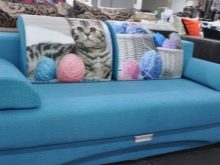
- Retro (60-70s of the XX century). Furniture should be compact, without excessive decor, but at the same time of different shapes. Strict and angular, with smooth curves and fantasy solutions are popular. The colors are classic, pastel colors with a predominance of geometric texture.

- Military it is distinguished by brutality and functionality, it is ideal for men. A sofa bed in this style should be a strict geometric shape, a little rough. The decoration should be in a minimalist style, but decoration with heraldic elements is allowed.

- Shabby Chic - the style of artificially aged things and their elements, creating a special atmosphere of bohemian chic. It is characterized by frayed legs and armrests with a predominance of light colors.
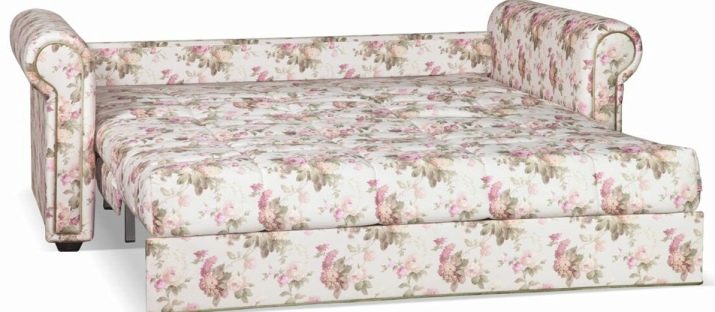
- Classic characterized by the obligatory presence of carving, overlays, gilding and other pretentious elements. Only natural materials are used, upholstery colors are mostly calm, with floral designs.



How are they laid out?
Unfolding and folding the teak-tock sofa bed will not cause difficulties and does not require much physical effort. It is recommended that you familiarize yourself with the operating instructions from the manufacturer of the product, it will indicate the personal characteristics of the model. Typically, this is the arrangement of handles or other elements to hold the pull-out panel during unfolding or folding, especially the support devices or surfaces, the way the back panel is folded and returned to its original position.

To unfold the sofa, you should adhere to the following algorithm of actions:
- remove decorative pillows and used coverings;
- lift the front of the pull-out panel and pull it outward until it is fully extended, then lower it;
- if necessary, fold the decorative pillows into pallet boxes;
- lower the back of the sofa to the vacant space, and do not forget to place the strap correctly for easy lifting of the panel.

To fold the sofa, follow these steps:
- raise the back panel to its original position, using the available strap for convenience;
- remove decorative pillows from the pallets;
- Lift the pull-out panel and gently push it towards the inside of the sofa until it is fully folded down.

Review overview
Customer reviews of sofa beds with a "tick-tock" transformation mechanism allows us to confidently consider it quite reliable and durable. Users unambiguously mark a positive aspect of the convenience of folding the sofa without the need to move the movable part on the floor or floor covering, especially those who previously had fold-out sofas with a system on casters, which were constantly entangled in the pile or left marks on the floor surface. And also for many, the positive point is that for use in a single version, there is no need to fold out the sofa bed, but simply remove the decorative pillows.
Negative reviews usually relate to decorative pillows, which often have dimensions that do not allow them to be stacked in pallet boxes, and during the use of the bed, they take up space in the room.
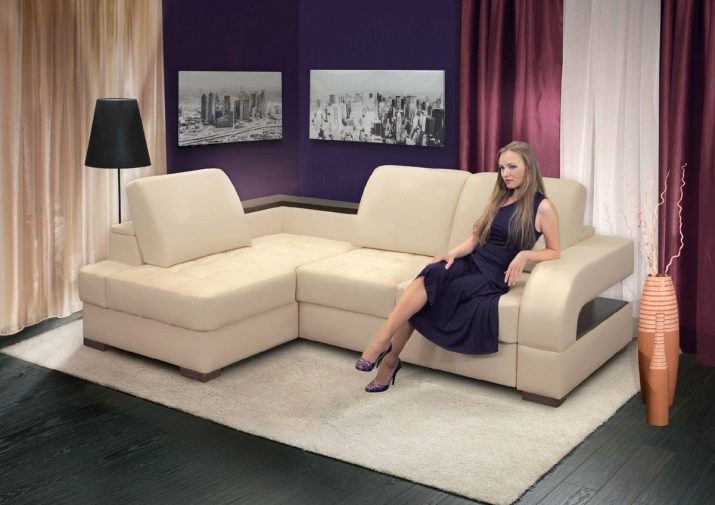
For information on how to fold and unfold the sofa, see the video below.








